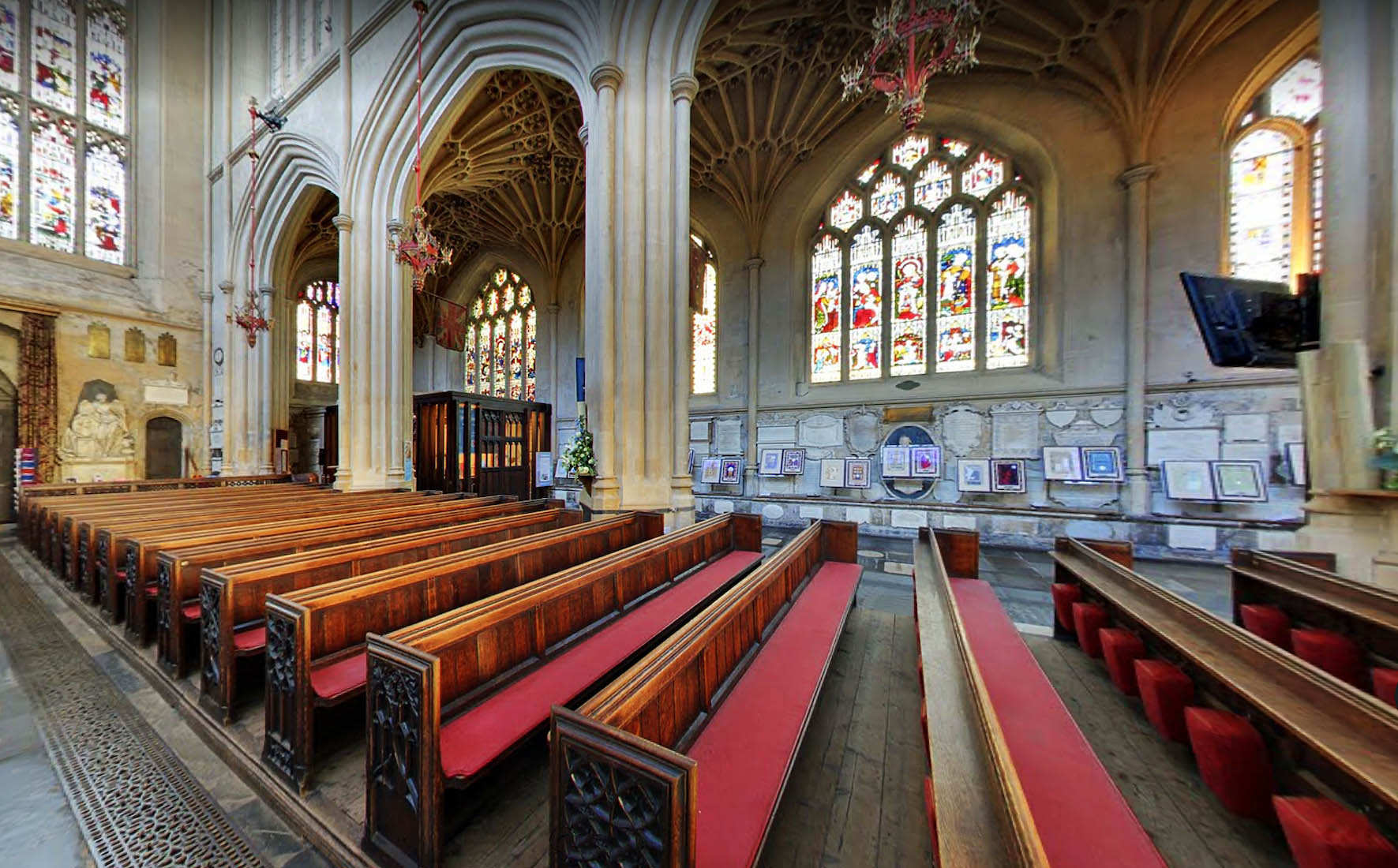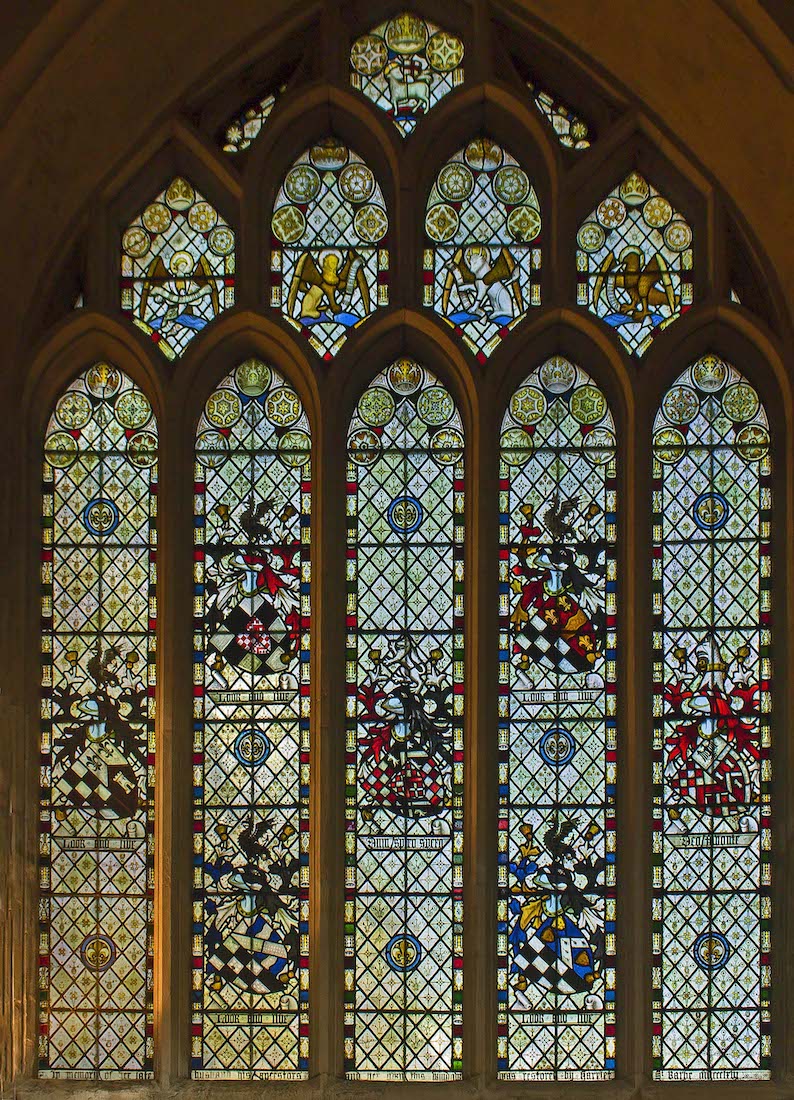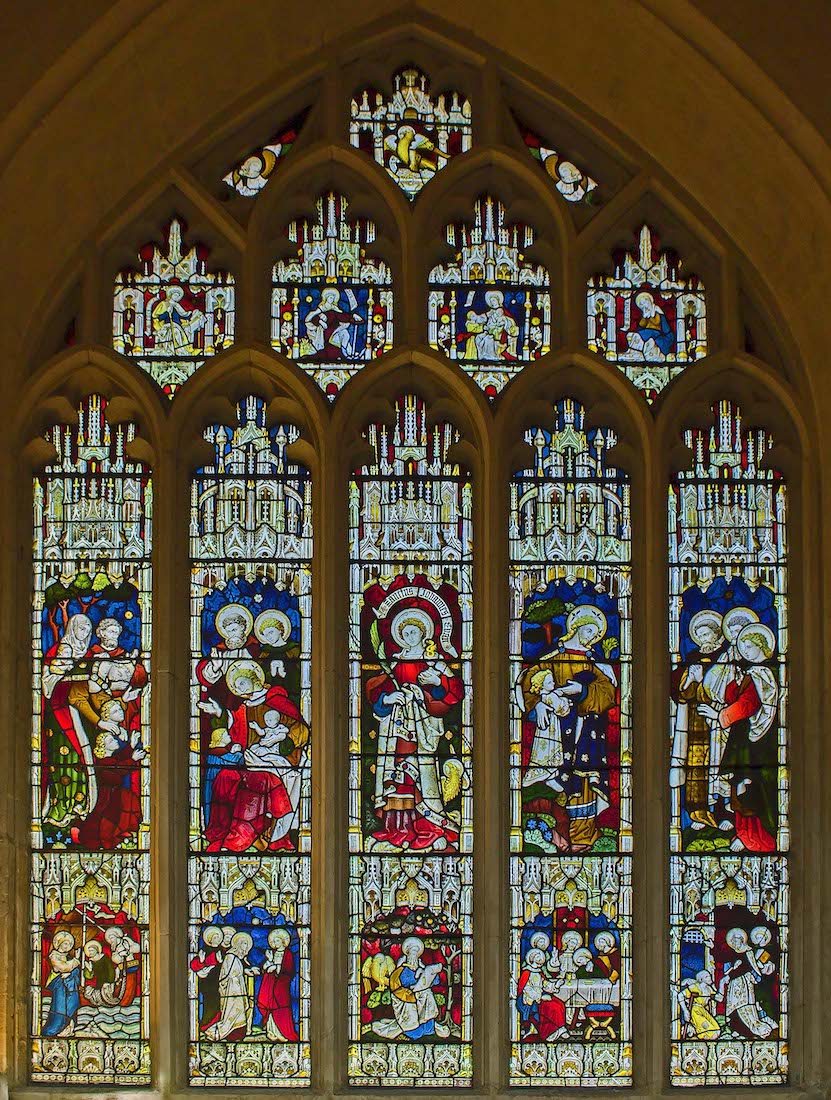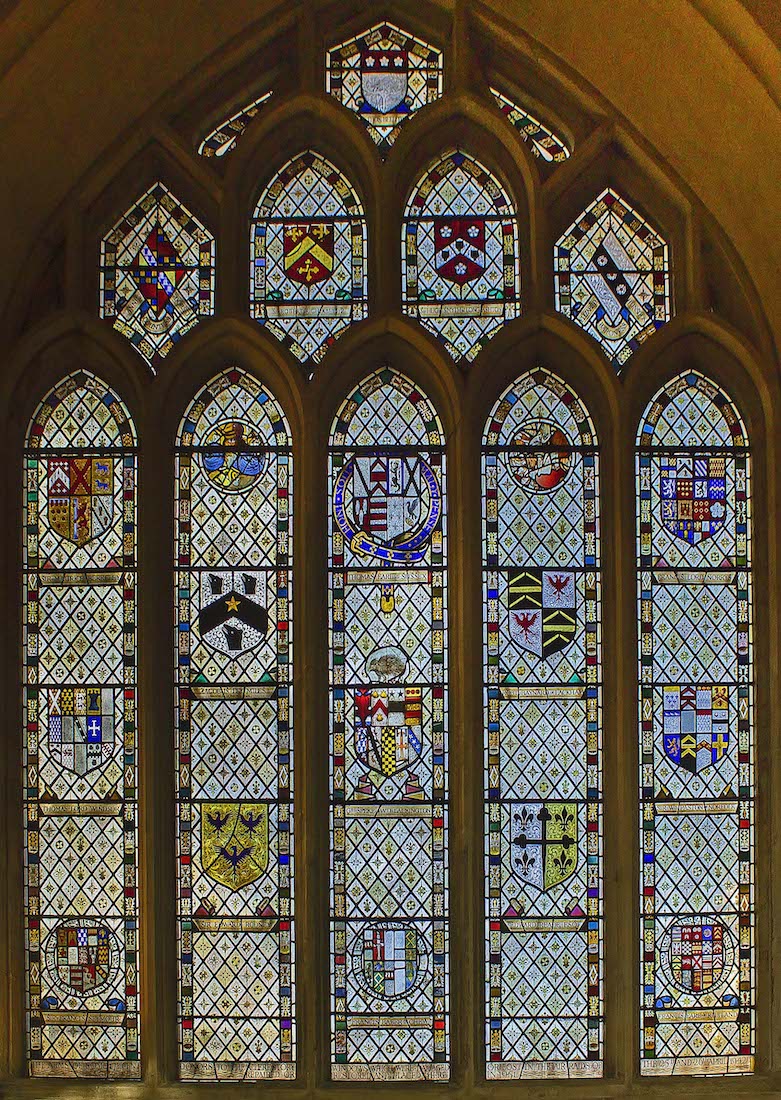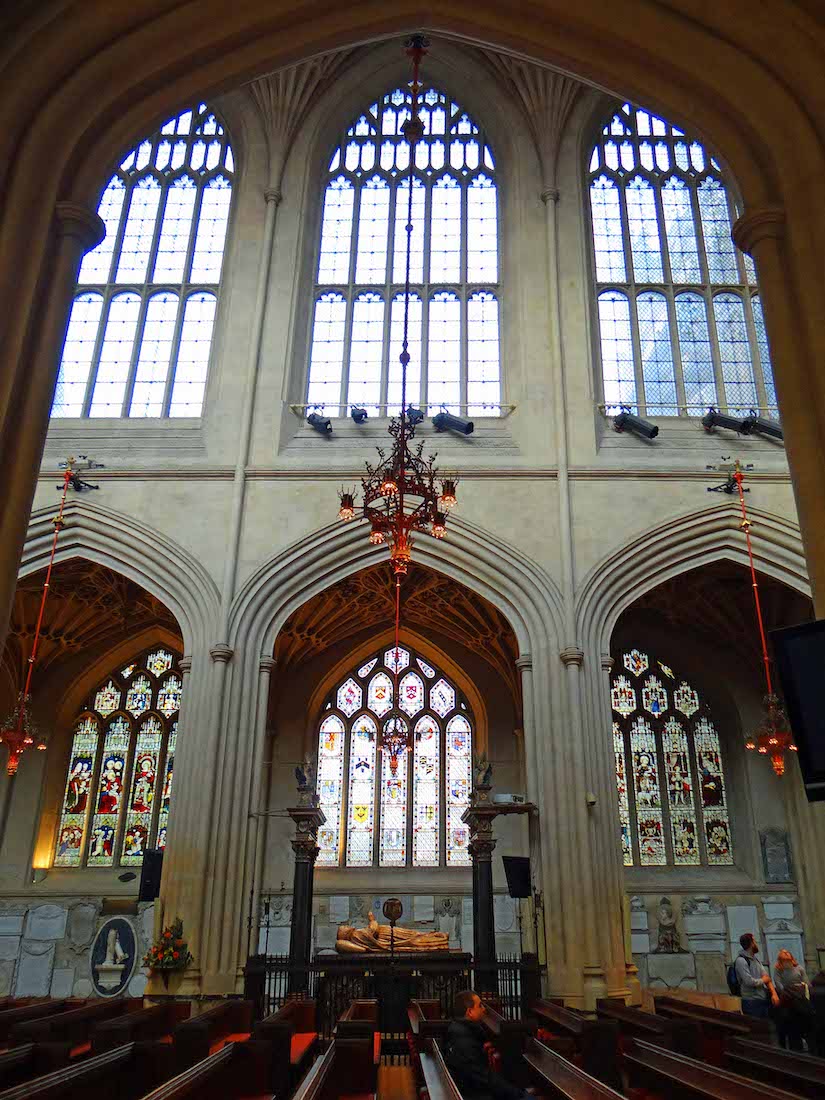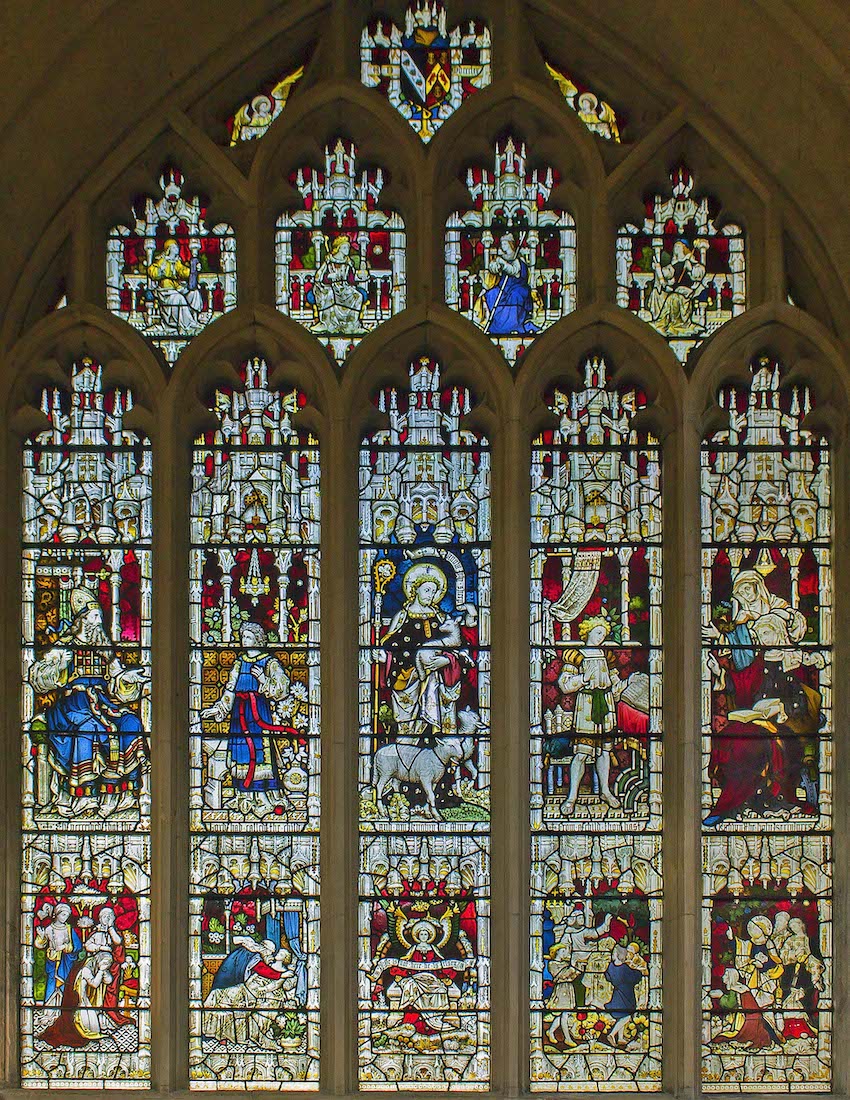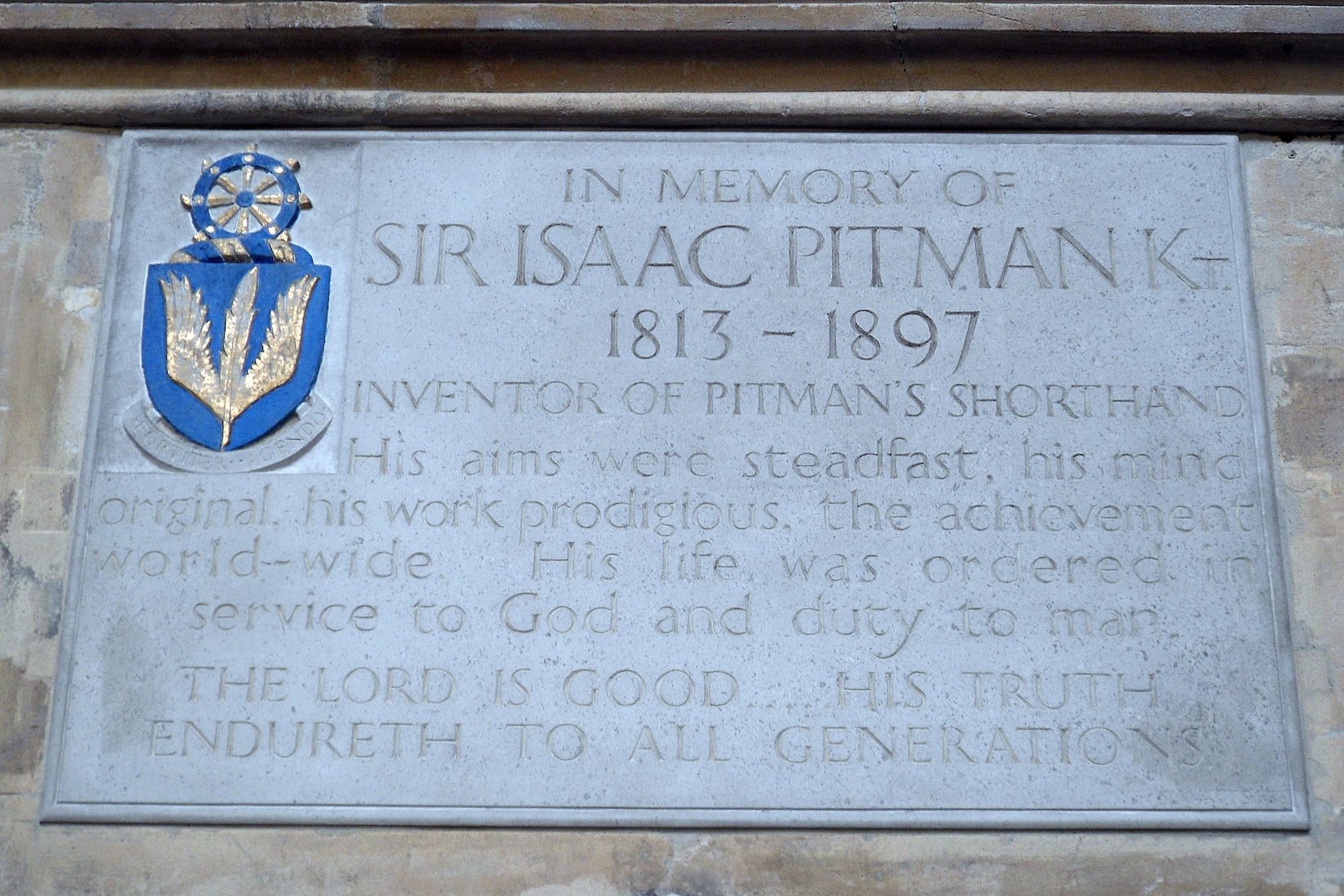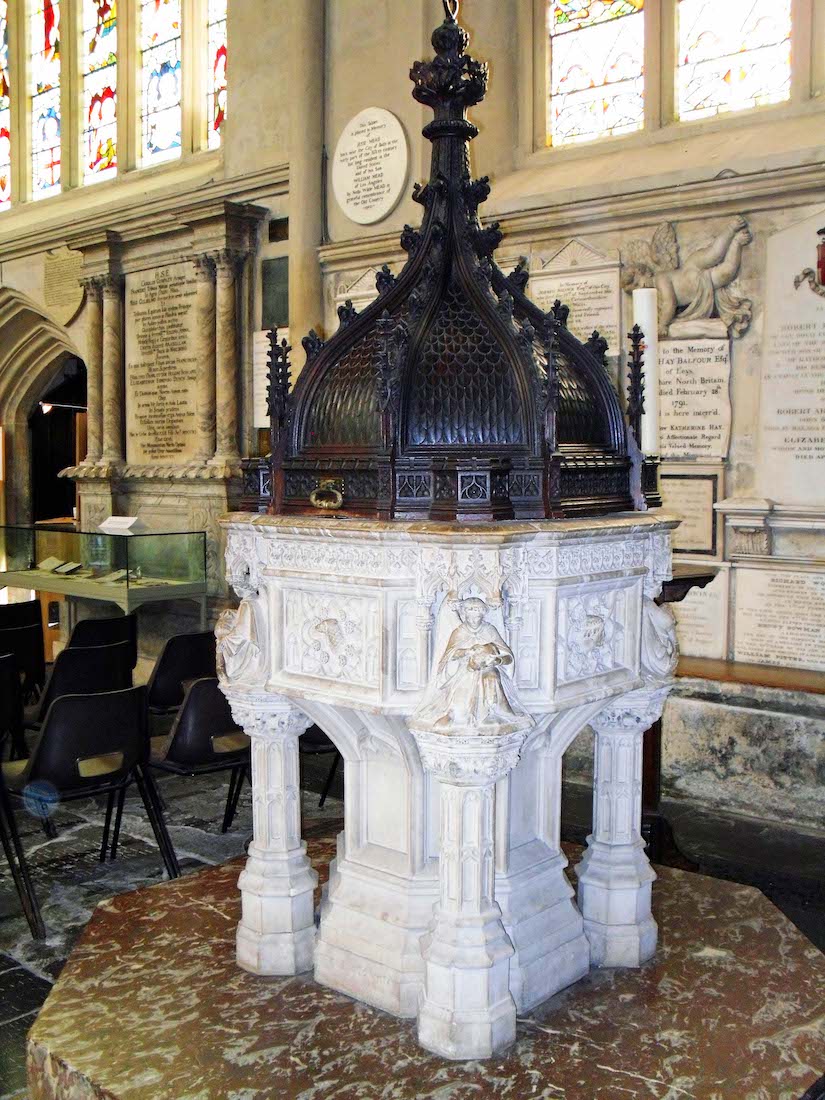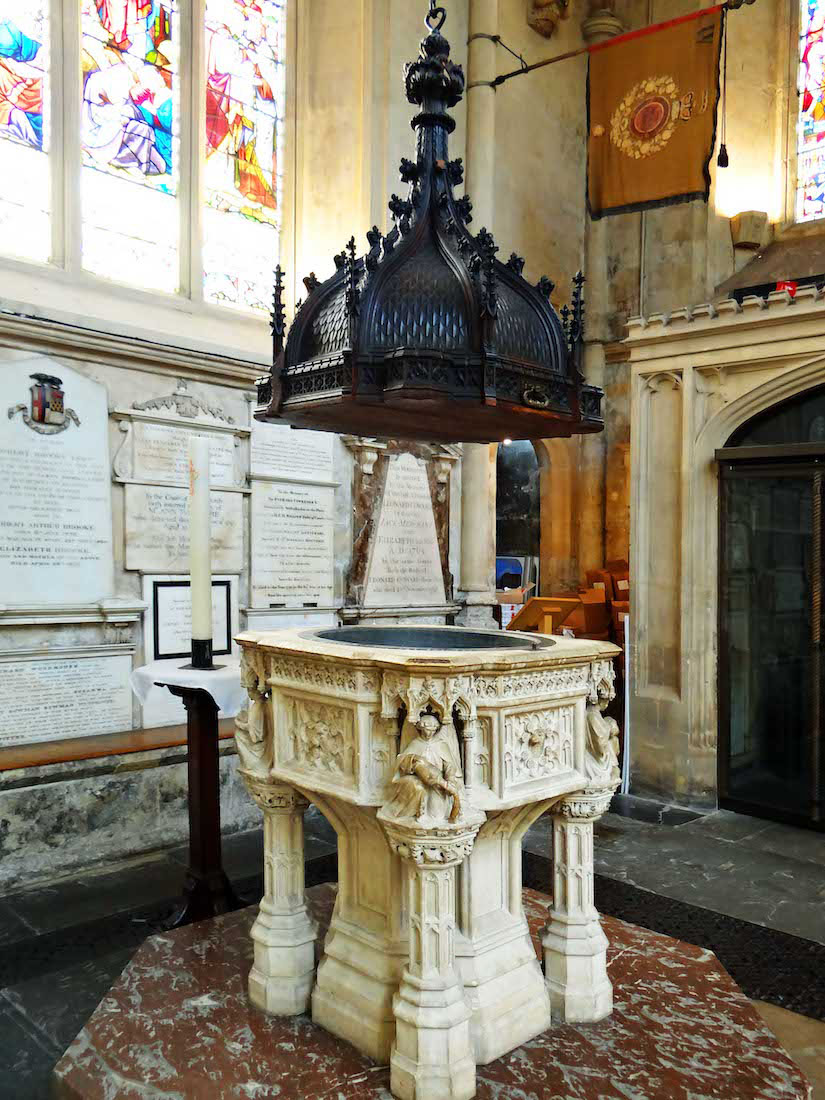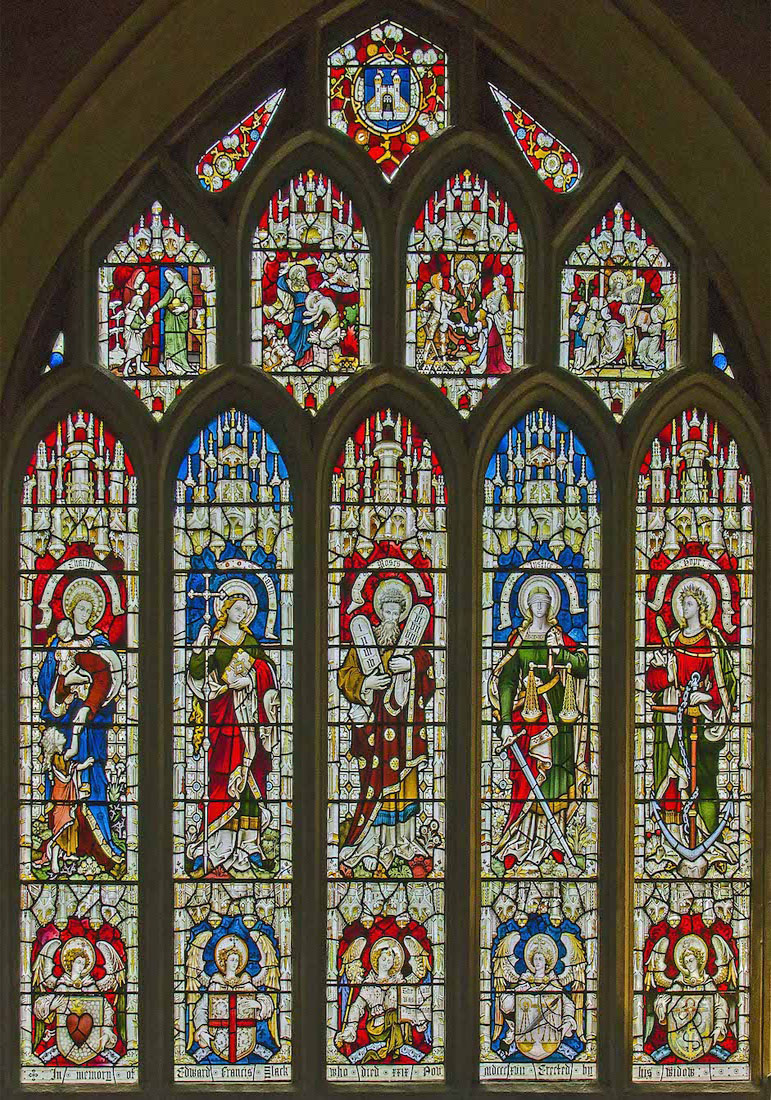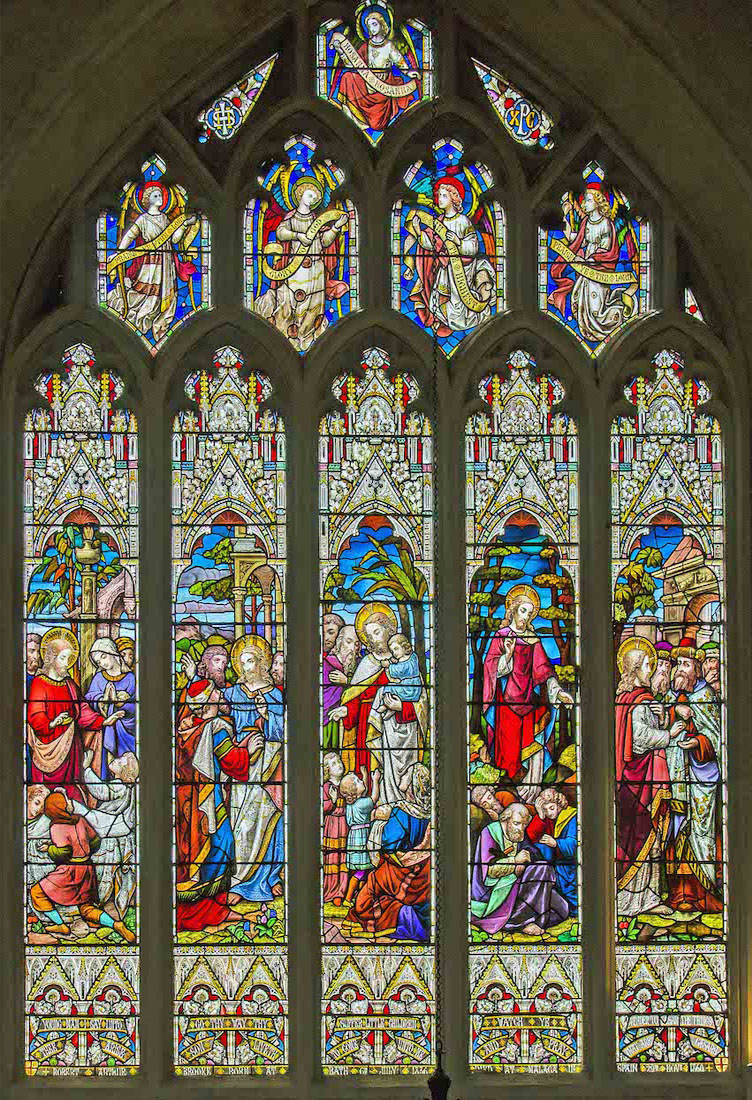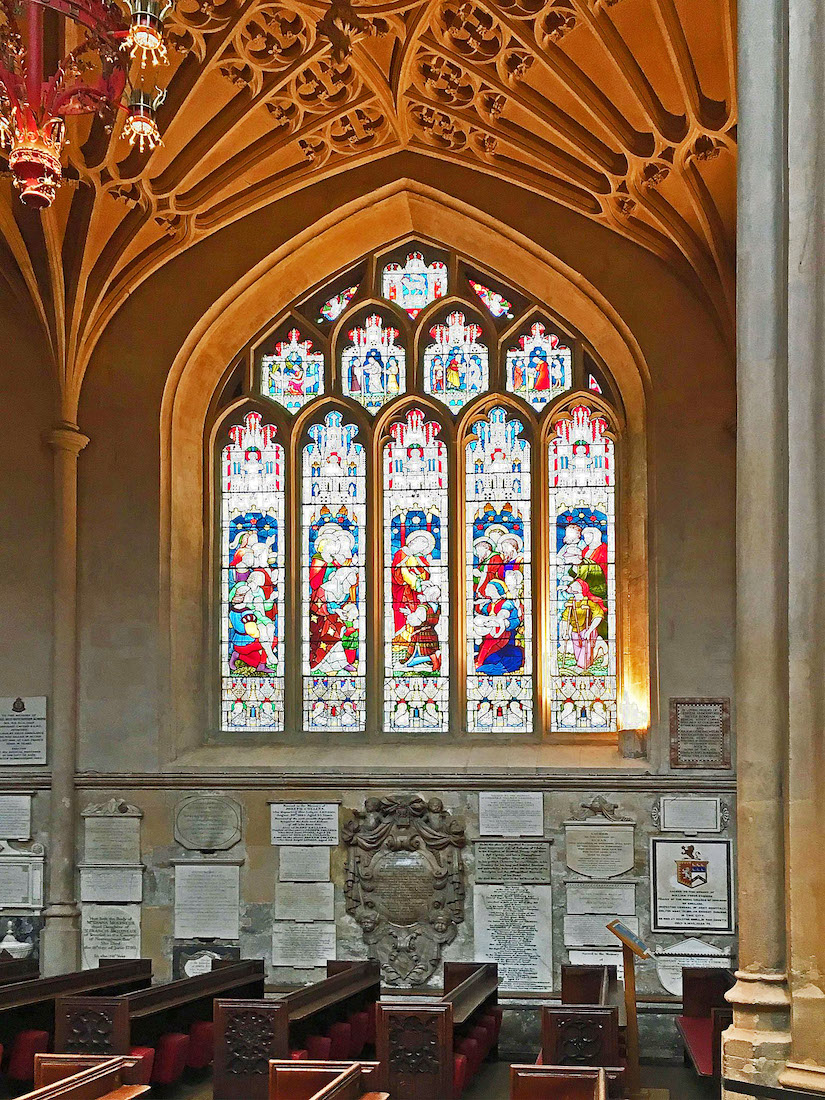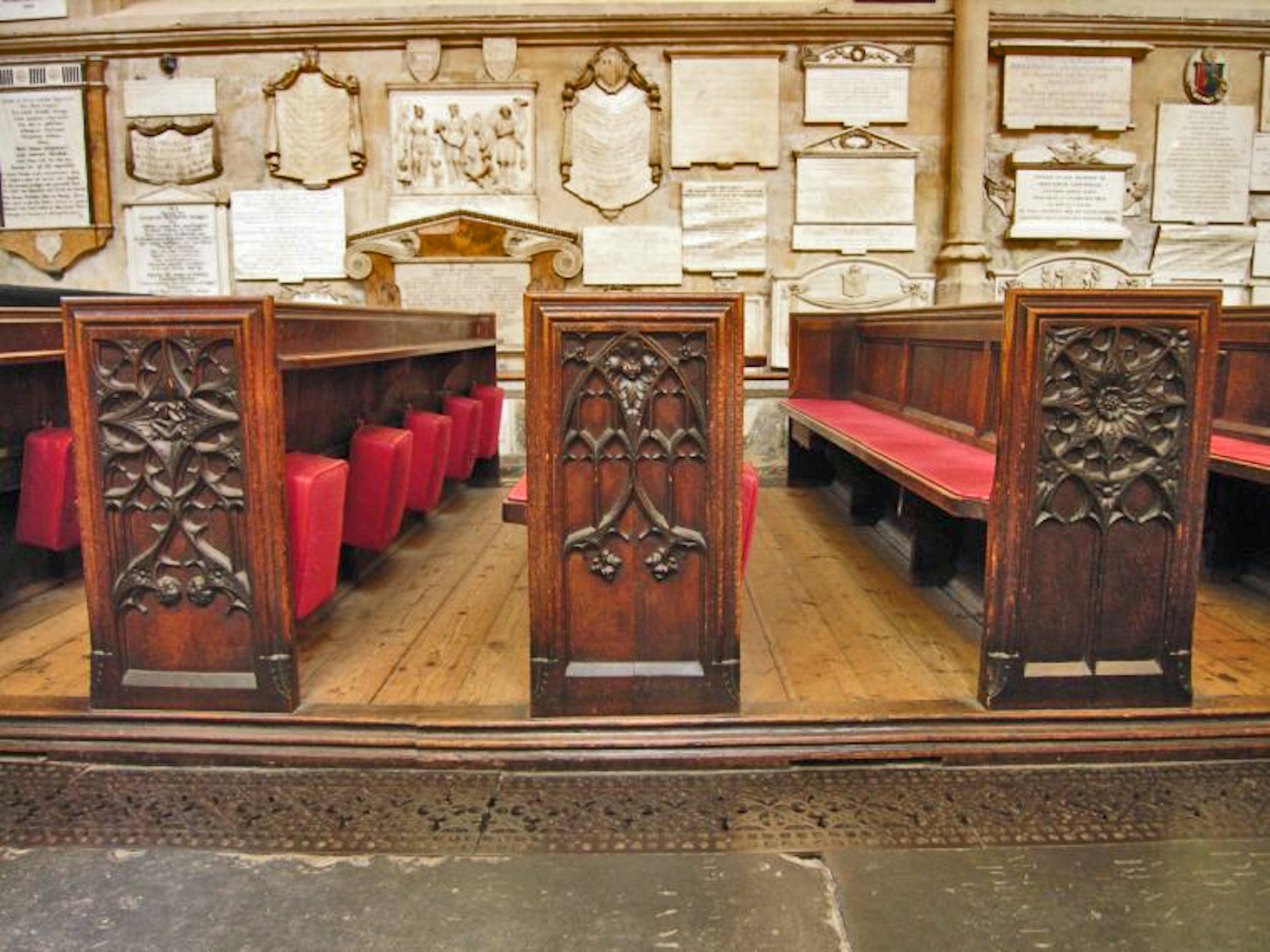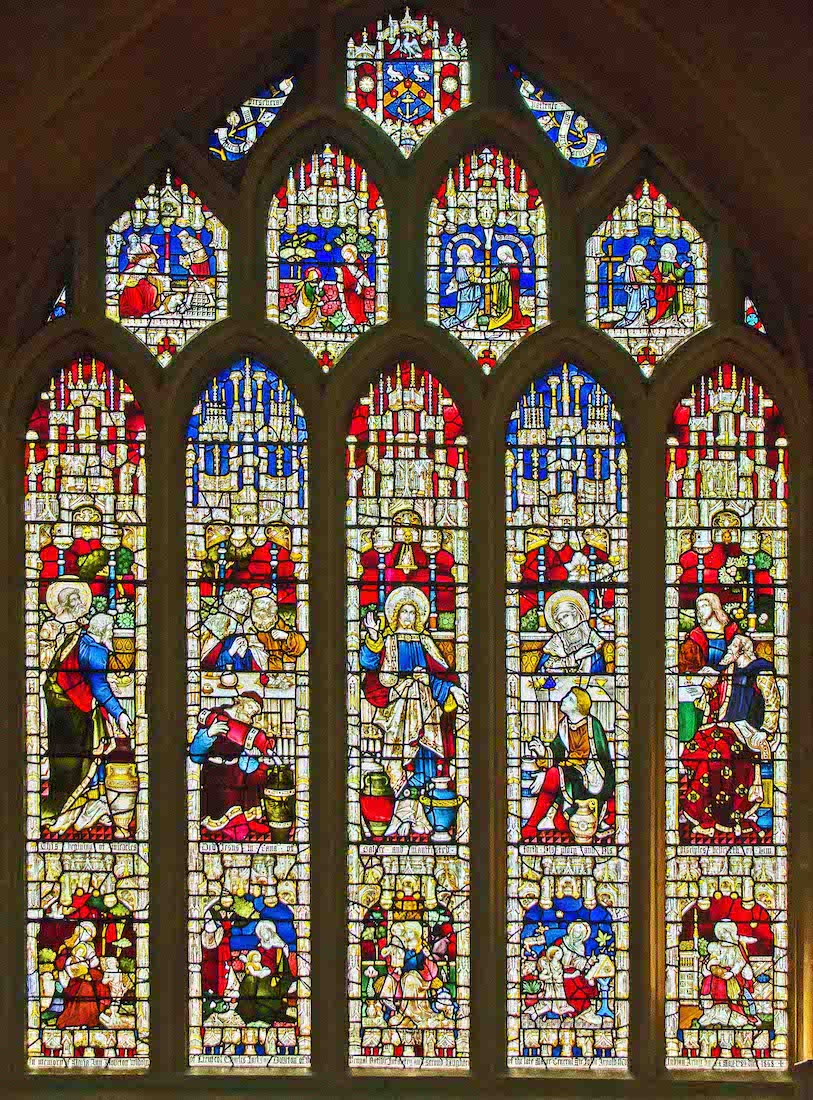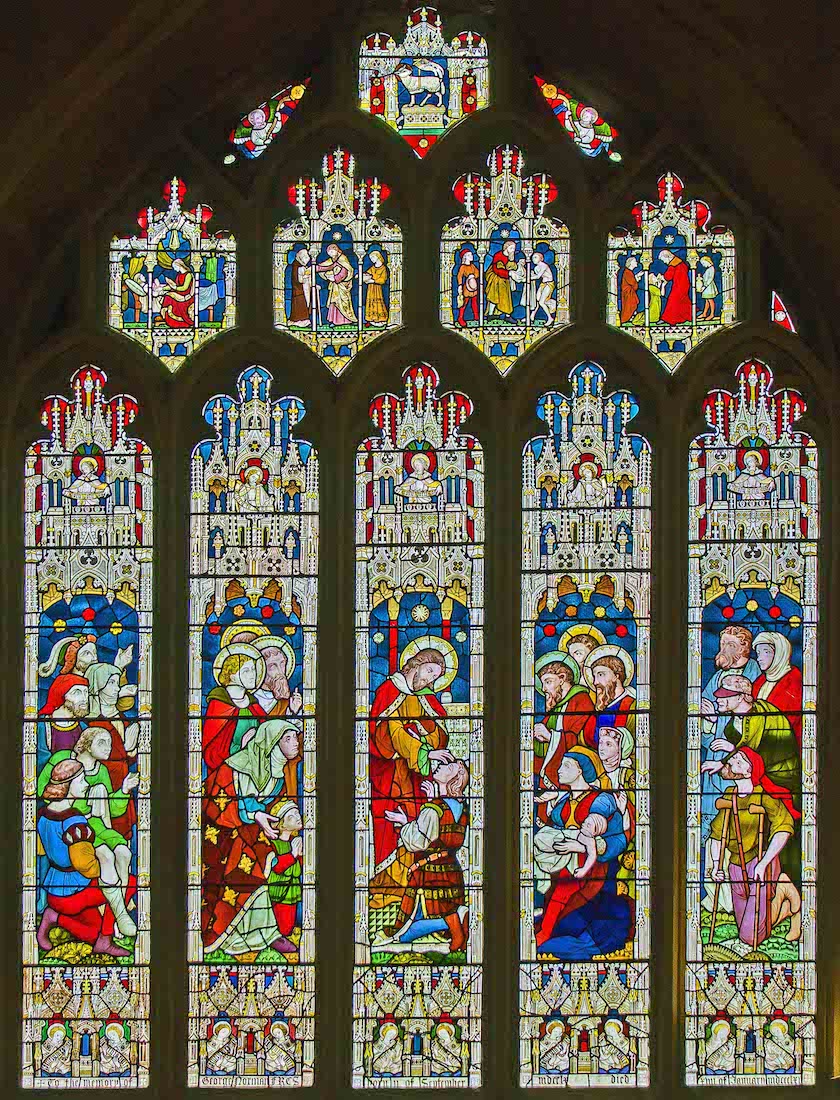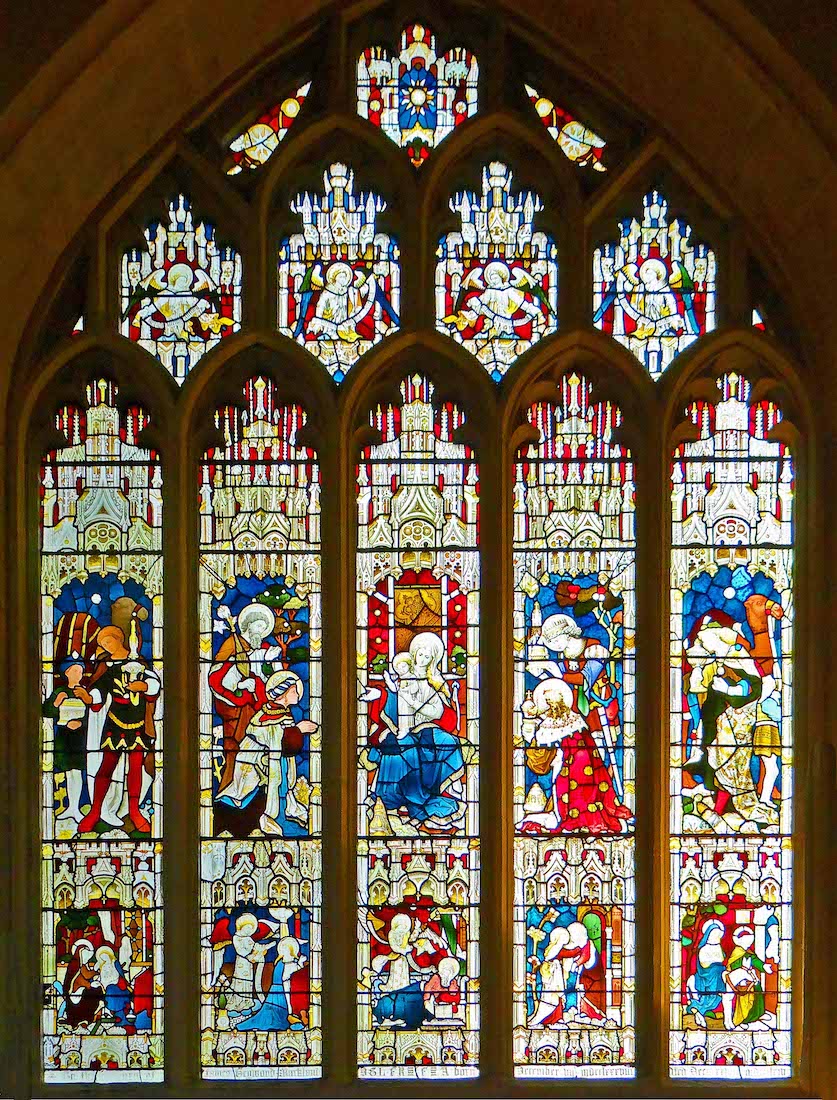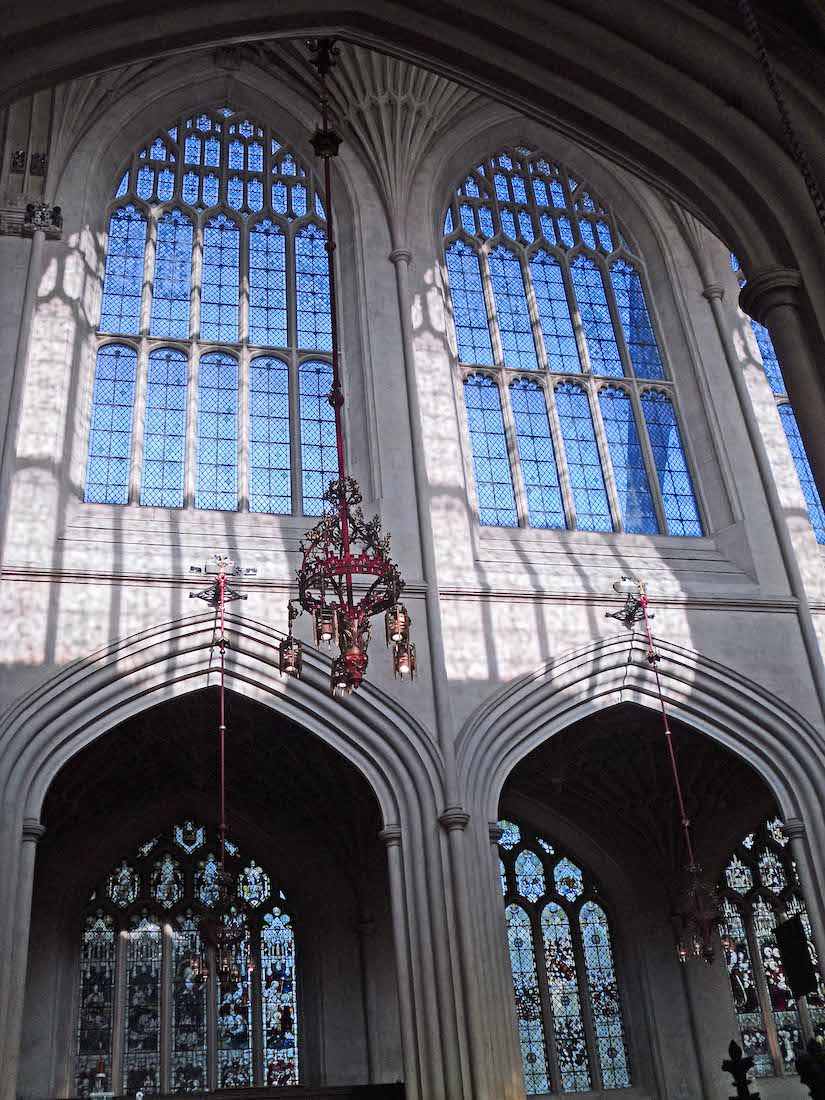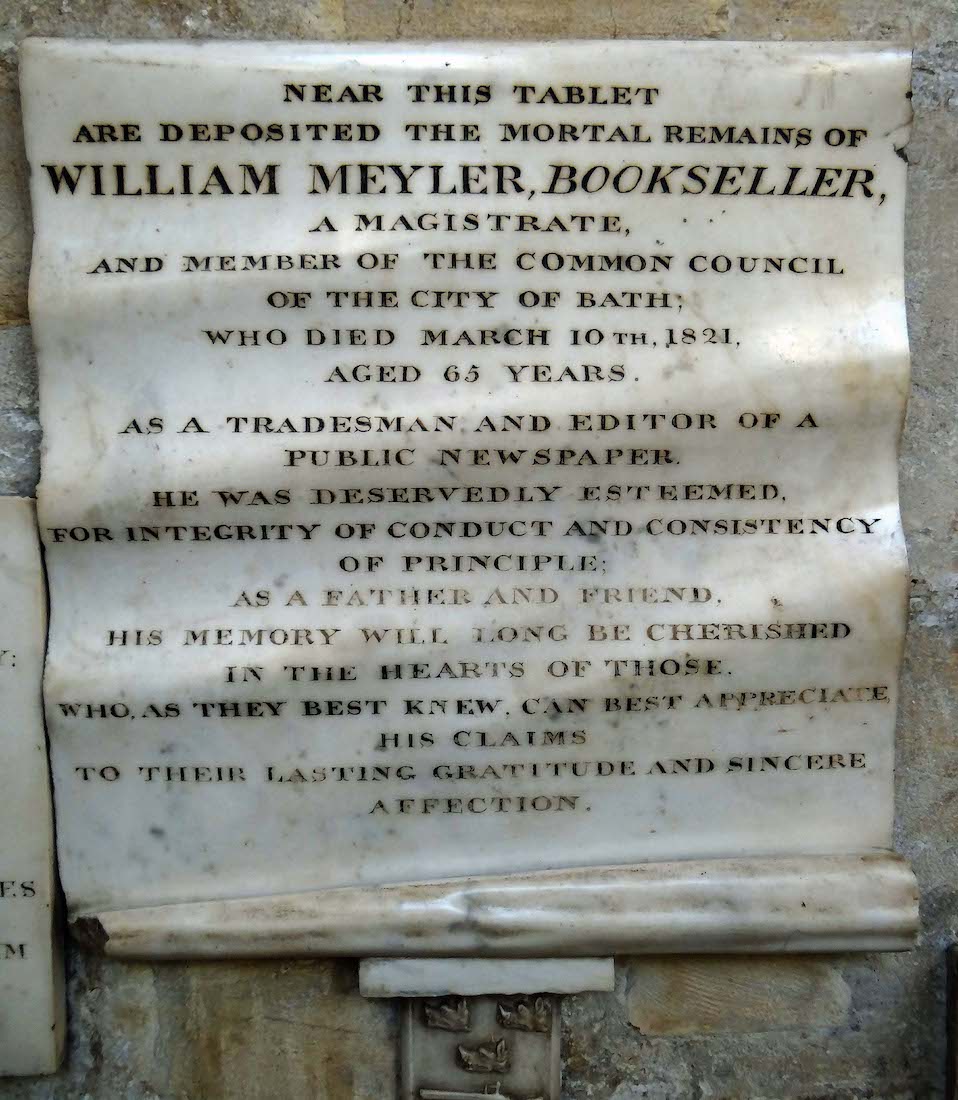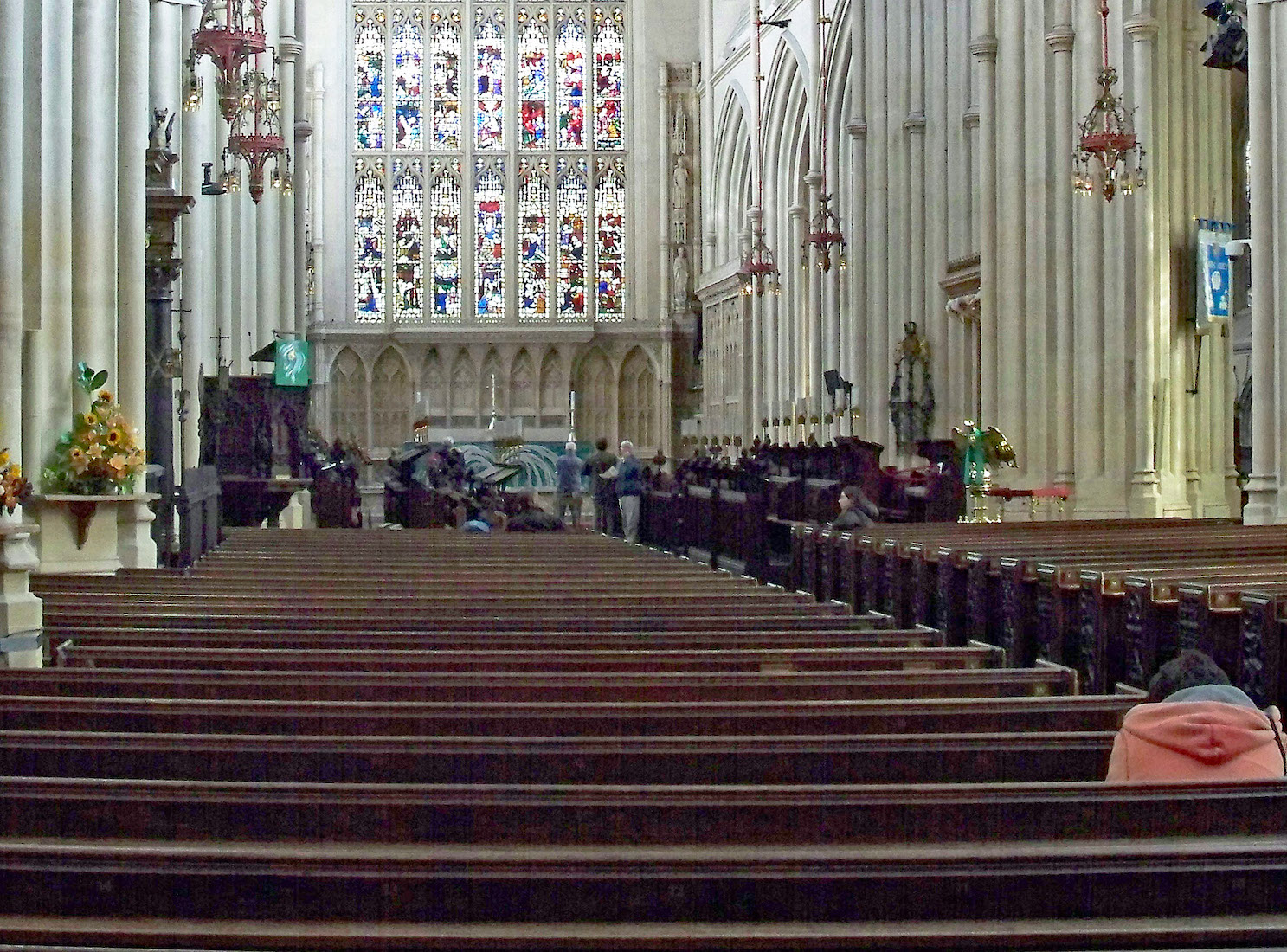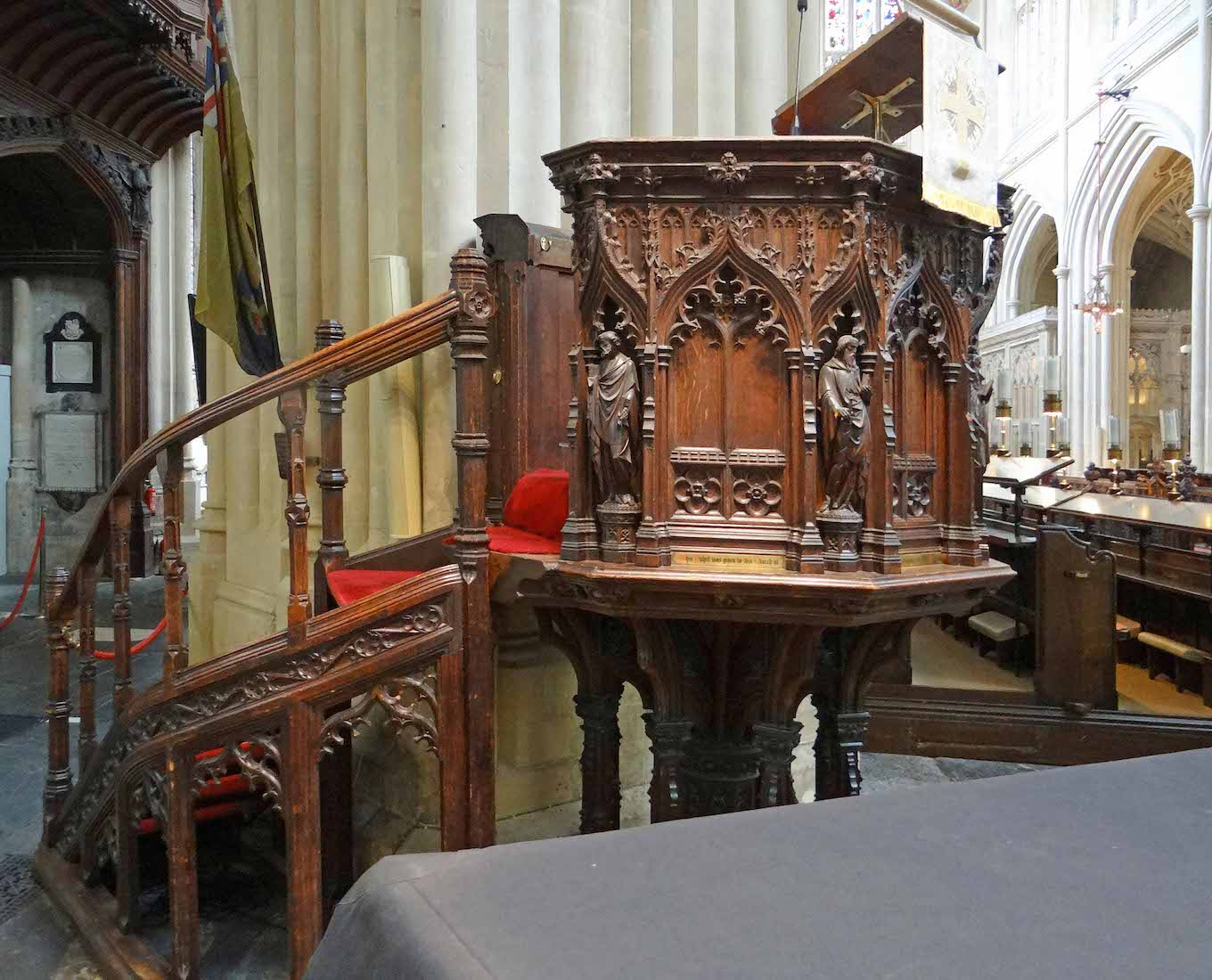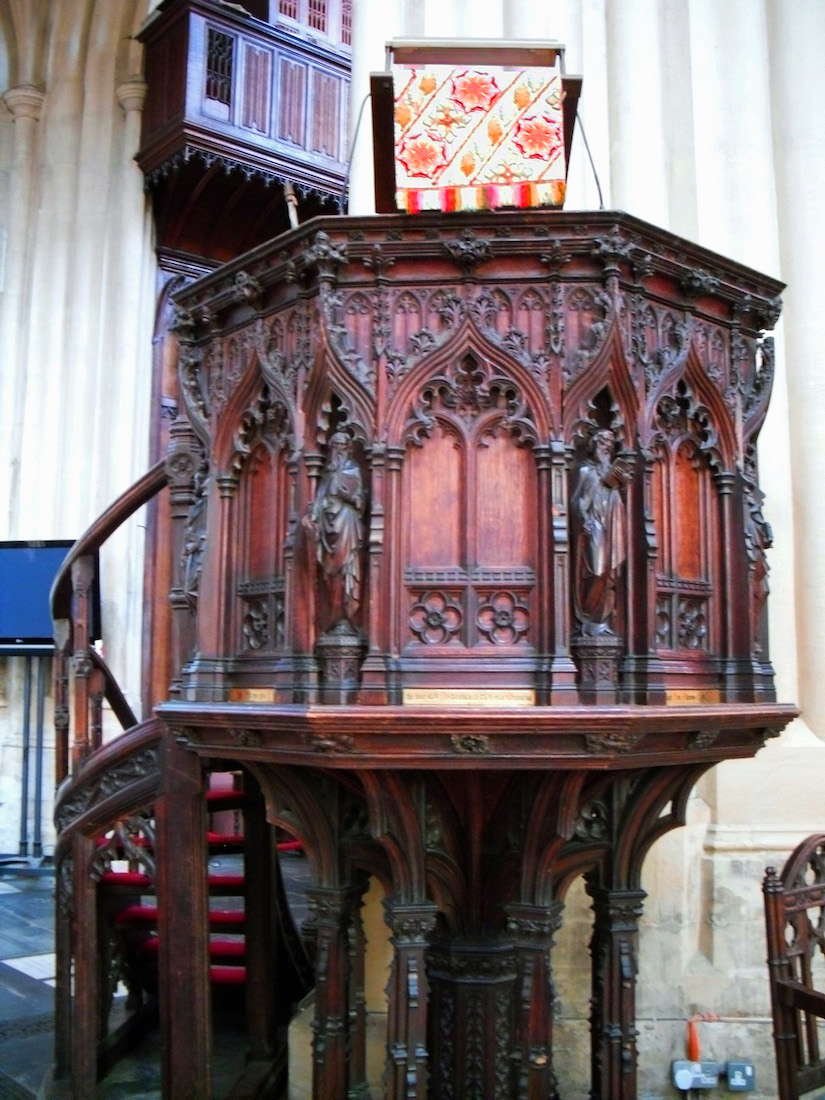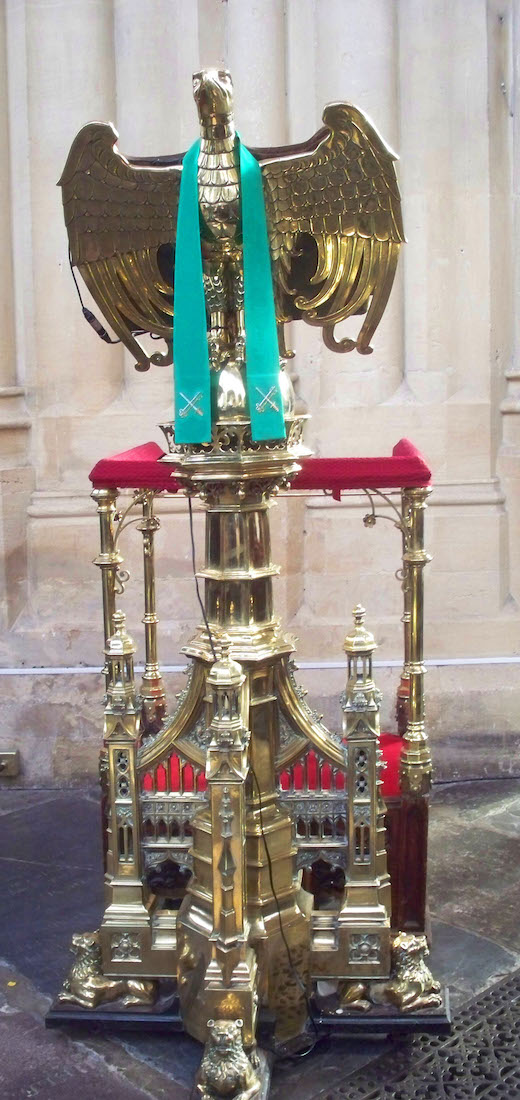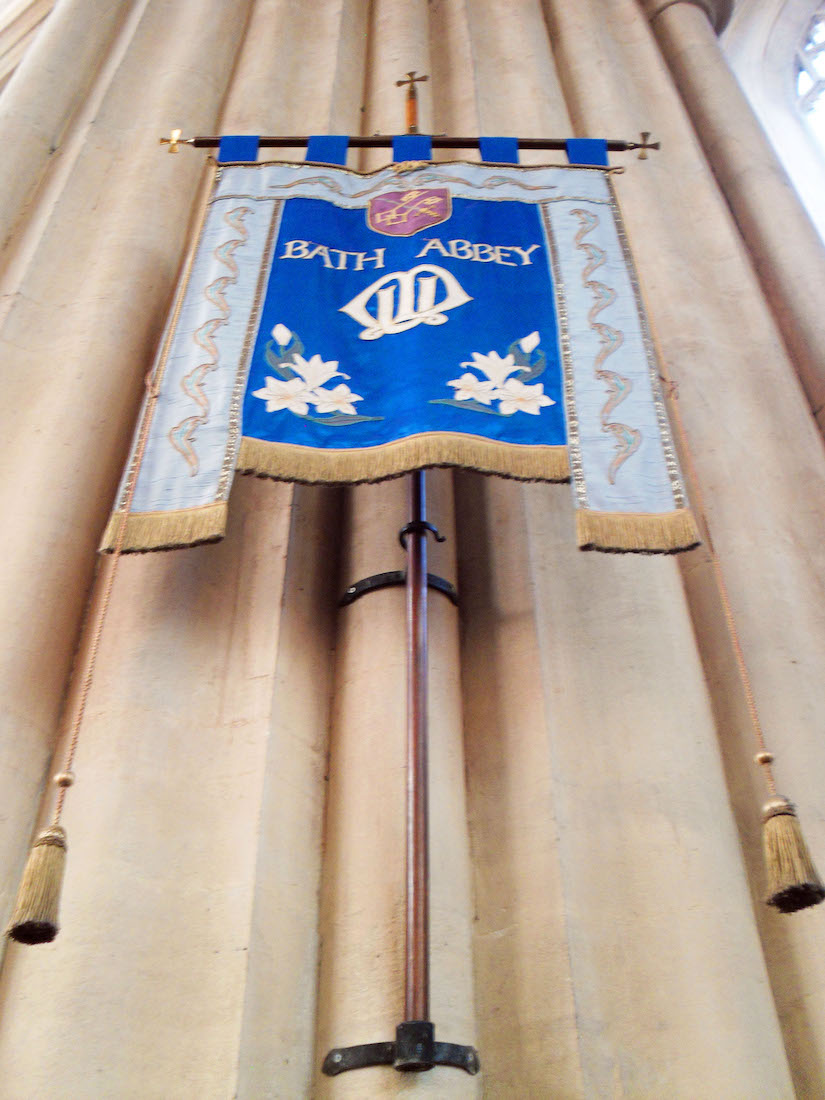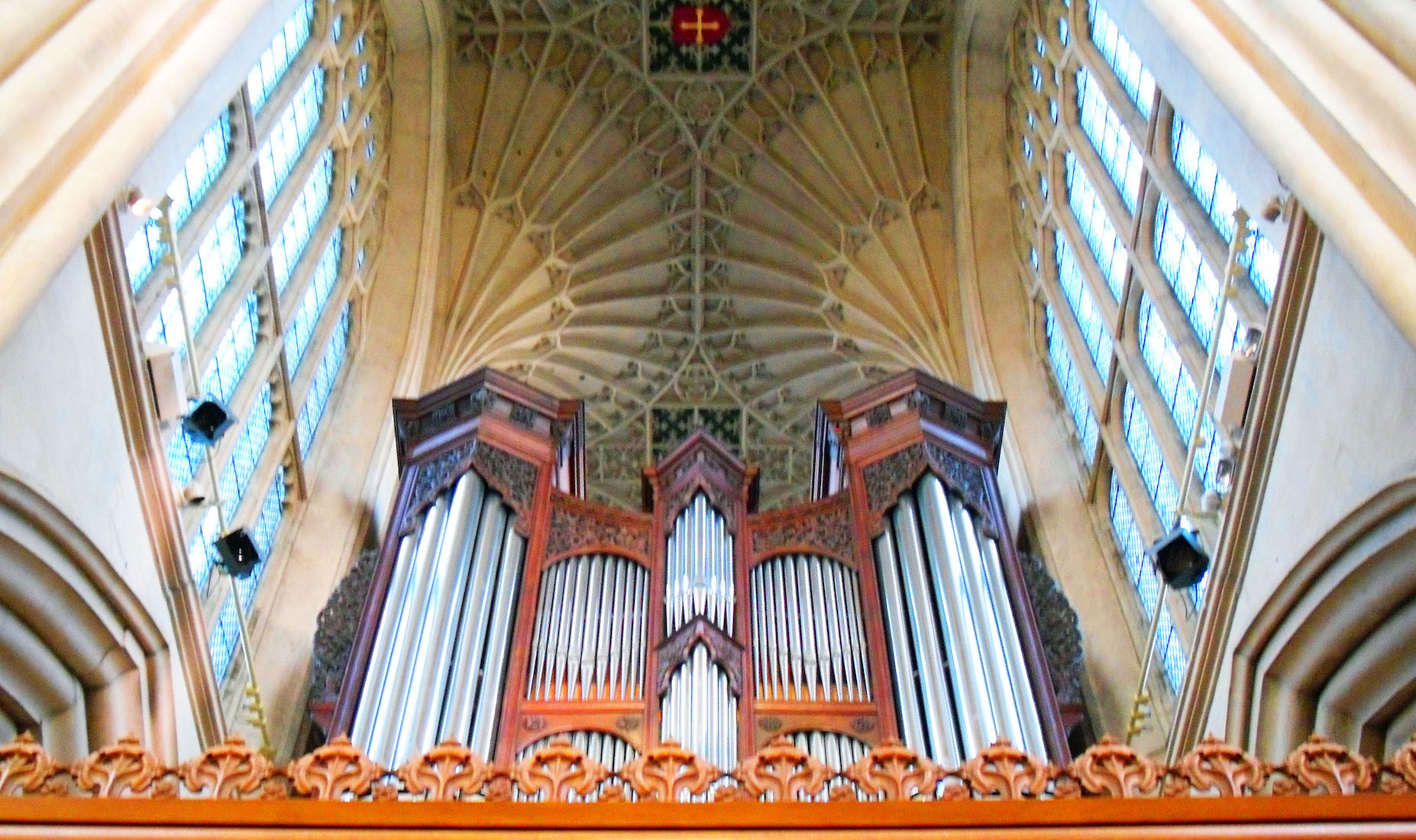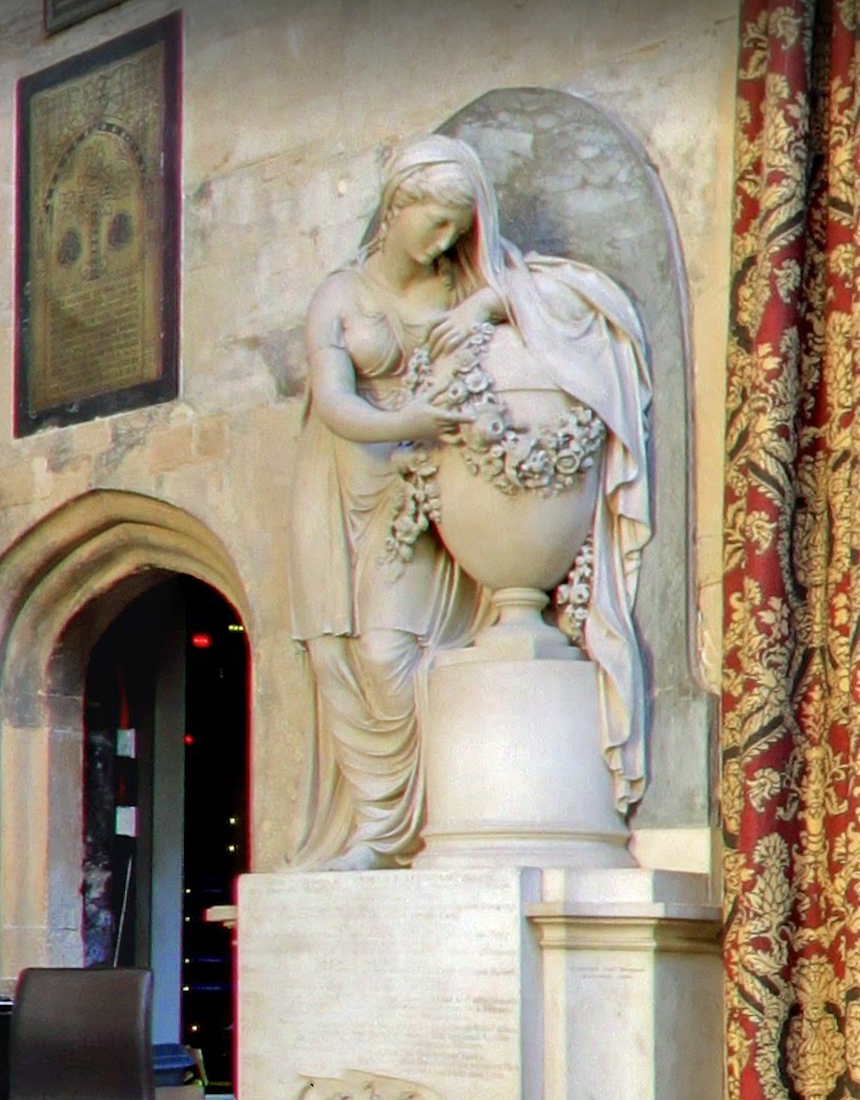
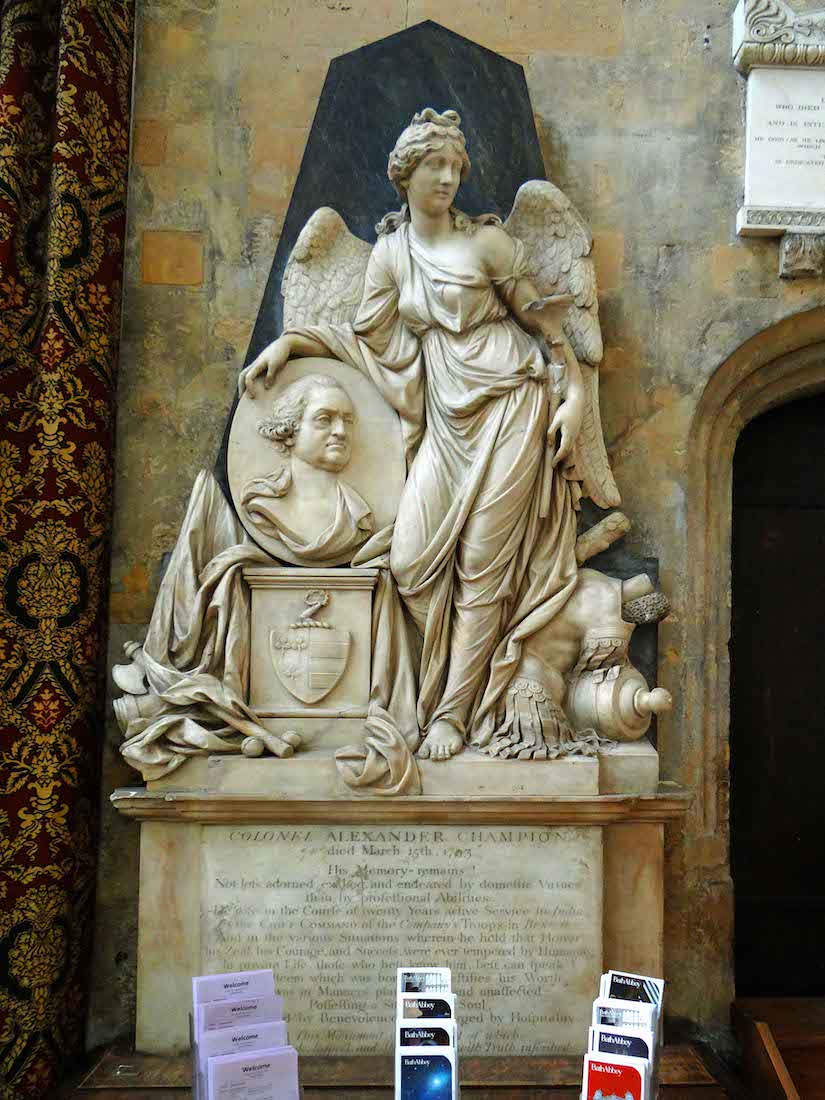
We look at the statues on either side of the West doors. • Shown at left is a sculpture of a grieving woman with ‘sensitively carved drapery’ which is a memorial to Herman Katencamp, by John Bacon the Younger (1777-1859). It appears that Katencamp was for many years the King’s Consul General for the protection of trade in the two Sicilies and in Spain. • The sculpture at right remembers Colonel Alexander Champion (died 1793) who served in the army of the East India Company for two decades. The sculptor was Joseph Nollekens. [Left Photo Credit: Google] INDEX
22. WEST WALL SIDE WINDOWS J&J RH
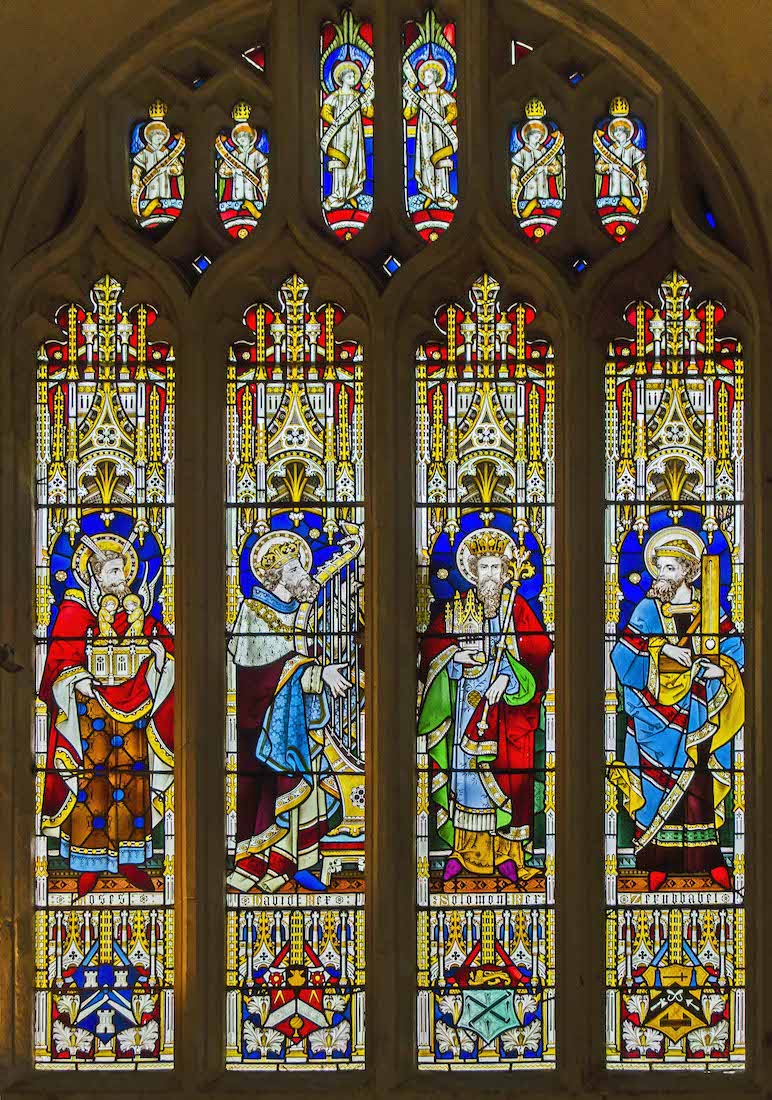

The window at left is on the font side of the Abbey. It shows Moses, David, Solomon and Zerubbabel as builders and makers of the Temple. The glass is by Bell of Bristol, late 19th C. The window was donated by contractors involved in the restoration of the Abbey in the 1860s and 70s. • The window on the other side is by Chance Bros., 1863, and is a memorial to Charles Empson, who died in 1861. It shows the Four Evangelists, as indicated by their symbols below: angel, lion, ox and eagle.
23. NORTHWEST NAVE G
The entry porch in the Northwest corner. We note here a number of the distinctive features of the Abbey: the stained pews with their carved ends, the colourful chandeliers, the strong vertical lines and elaborate vaulting, the 52 windows occupying 80% of the wall space, and the 635 memorials lining the walls. There are also 891 ledger stones (gravestones) forming the Abbey floor. [Photo Credit: Google]
24. NORTH NAVE WINDOWS RH J&J
We investigate the North nave wall, beginning at the West end, and first looking at the stained glass windows. • The first window is by Clayton and Bell, 1866-72. The theme appears to be women of the Bible: (from left) Hannah praying before Eli; Pharaoh’s daughter finding baby Moses; Ruth gathering wheat sheaves; Jesus visiting Mary and Martha; unknown. • This window shows seven shields of the St Barbe family with much glass from 1614. It is a reconstruction by Clayton & Bell.
25. FURTHER NORTH NAVE WINDOWS J&J J&J
The third window along has Clayton and Bell glass. The main central panel shows John the Evangelist. On either side are panels showing Jesus with children • The Coats of Arms in the window shown at right were originally located in the clerestory windows, but relocated here after damage in the Air Raids of 1942. One Coat of Arms still remains in the clerestory. Some date from the early 17th C. and they represent benefactors who donated to help restore the Abbey after the dissolution. The glass is by Bell, 1951.
26. CLERESTORY AND LAST NORTH NAVE WINDOW RH J&J
At left we look straight across the nave towards the North wall. The large clerestory windows in the nave are clear, making the Abbey light and bright. Directly ahead of us is the James Montagu tomb and effigy. • The window to the right was a gift of Rev. Prebendary Charles Kemble who was Rector here 1859-75. It contains an image of Jesus as the Good Shepherd surrounded by depictions of youthful piety. Kemble’s son drowned aged 15 whilst in the Royal Navy. The glass of the window is by Clayton & Bell.
27. PITMAN PLAQUE WH
This memorial plaque to Sir Isaac Pitman is just one of the many along the North nave wall. Sir Isaac Pitman (1813 – 1897) was a teacher of the English language who developed the most widely used system of shorthand, known now as Pitman shorthand. He first proposed this in ‘Stenographic Soundhand’ in 1837. He was also the vice-president of the Vegetarian Society. Pitman was knighted by Queen Victoria in 1894. Two more monuments can be seen here.
28. MONTAGU TOMB IS
This is the elaborate alabaster tomb of Bishop Montagu, who was Bishop of Bath & Wells from 1608-1616. He was the son of Sir Edward Montagu of Boughton House in Northamptonshire. In the early 17th century, when the Abbey was in ruins, Bishop Montagu paid £1,000 (then a vast sum) to restore its roof, and by 1616 the previously ruined building was repaired and back in use. The roof was subsequently replaced in 1870 with the amazing fan vaulted ceiling we see today. More views of this tomb can be seen here.
29. FONT WH RH
Leaving the Montagu tomb, we walk back across to the font in the Southwest corner of the nave. This fine Victorian font was one of the last additions to Bath Abbey made by Gilbert Scott in 1874. We notice that the font stands in a corner faced by two windows. More views of the font can be seen here.
30. SOUTH NAVE WINDOWS J&J J&J
Here are shown the first pair of windows from the West on the South wall. • The window at left depicts five figures: Charity (with children), Faith (with Cross and Bible), Moses (with Tablets of the Law), Justice (with scales and sword) and Hope (with anchor). Angels across the base hold corresponding symbols. • The panels of the window at right show Jesus teaching, and mingling with the children .
31. WINDOW AND MONUMENTS PRS
The central window on this wall is seen here, above an impressive display of monuments. We notice again the carved ends of the pews.
32. PEW ENDS CT
The ends of the pews display a pleasant and varied array of carvings. In the foreground we catch a glimpse of a couple of the ledger stones paving the floor. [Photo Credit: Christianity Today (Requested)]
33. SOUTH NAVE WINDOWS J&J J&J
We come to the next two windows in the South nave wall. The left window depicts Christ healing the sick, based on a picture by Friedrich Overbeck. The glass is by Clayton & Bell, and the window is in memory of George Norman FRCS. • The (central) window at right dates from ca 1868. It is a window about healing, with Jesus healing a blind man in the central panel, and other afflicted people approaching from left and right.
34. WINDOWS RH WH
The final window on this South wall is by Clayton and Bell, 1868-73. It is a rather jolly depiction of the Nativity, with people from various walks of life bringing gifts for the Christ Child. At right is a cheerful sight with the sun shing through one set of nave clerestory windows onto the other.
35. SOUTH NAVE MONUMENTS RH IS
Here are two monuments on the South nave wall. The tablet at left is particularly interesting as it remembers William Meyler, Bookseller– a relatively undistinguished man who was remembered for his integrity, and loved by family and friends. The other memorial pictured here is for the eminent William Tudor Esquire. Some more monuments can be seen here.
37. PULPIT RH WH
The carved Jacobean pulpit was designed by Farmer & Brindley, c1870.
38. LECTERN AND BANNER RH WH
The brass lectern assumes the traditional form of an eagle standing on a globe, but this lectern has a very substantial base. The blue banner celebrates the Mothers’ Union (MU). The incorporated logo of two keys and a sword is actually the Winchester Arms.
39. KING EDGAR STATUE IS
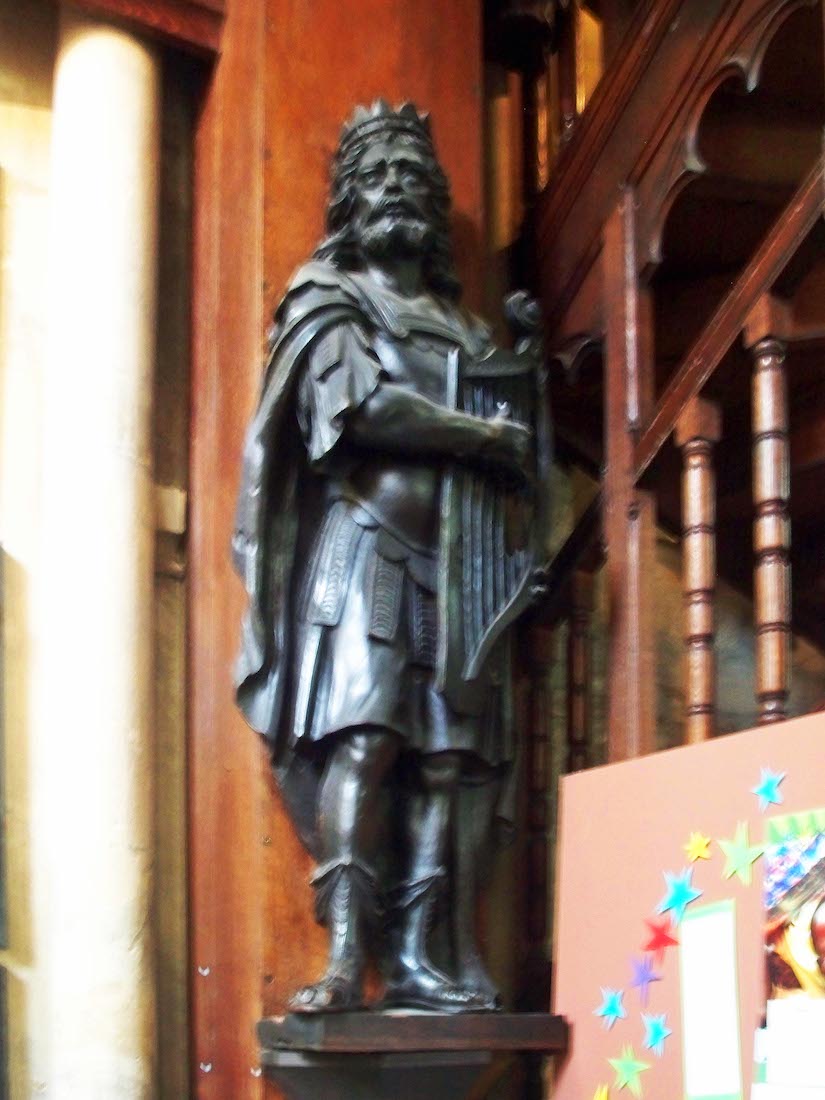
Most of the North transept is taken up by the Abbey pipe organ, but we may find King Edgar standing close by, clutching his lyre. King Edgar was crowned King of all England in Bath on Whitsunday 973. The service used for Edgar’s coronation was compiled by Dunstan, who was Archbishop of Canterbury. The same service has been used at every coronation since. In 1973, Queen Elizabeth II visited Bath Abbey for a service to mark 1000 years since the coronation of King Edgar. There is a stone commemorating this royal visit in the floor of the Abbey.
40. ORGAN WH
Bath Abbey’s organ is the most magnificent of the eight organs which have previously been in the Abbey. It was rebuilt by Klais of Bonn in 1997 as part of the Abbey 2000 restoration; and has over 4000 pipes. The casing on which it sits was designed for a previous organ installed in 1913 by Sir Thomas Jackson.


